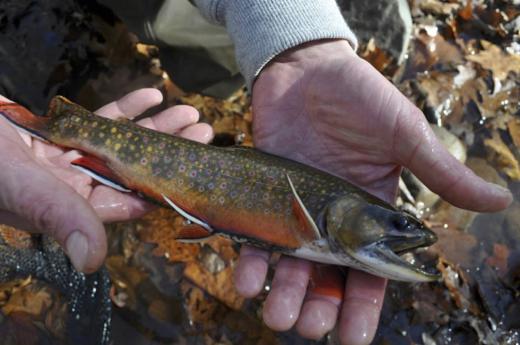
Goals
The Eastern Panhandle of West Virginia is drained by a portion of the mighty Potomac River, and has abundant trout resources. The region is graced with Karst, limestone geology that provides streams with cold buffered spring water. The panhandle boasts three intact native brook trout fisheries located within the Monongahela and the George Washington National Forests, and the area is a destination fishery for anglers throughout the East. TU is working to restore degraded riparian and in stream habitat to reconnect isolated headwater populations of brook trout back to the main stem rivers to increase size of the native fish and strengthen these populations.
Tactics
TU is working with landowners to improve the fishing opportunities on private and public lands. Staff works to restore riparian habitats by installing agricultural exclusion fence, alternative water sources, armored stream crossings and tree plantings. These services help stabilize eroding stream banks and keep water temperatures cold, while still providing access to water for livestock and landowners. Staff also works with landowners to install in stream habitat restoration projects which stabilize eroding stream banks and enhance in stream habitat necessary for spawning, seeking refuge and foraging. Structures such as perched culverts and low water bridges, serving as barriers to brook trout passage and dispersal, are being replaced with fish and vehicle passage friendly structures to reconnect streams to headwater sources. Volunteers are engaged in select projects to monitor streams, plant trees, and help spread the TU mission. The program also provides professional level courses to state, federal, and private entities focusing on brook trout stream ecology and restoration. TU is also working with the U.S. Forest Service to improve stream habitat and connectivity within the Monongahela National Forest.
Victories
Accomplishments include:
- 25 miles of stream restoration, including using rock and logs to provide pools and runs for fish and people
- Mitigation of 5 barriers to fish passage to reconnect over 20 miles of spring fed headwater sources
- Restoration of over 500 acres of riparian habitat
- Engagement of more than 1,000 local volunteers in the form of TU members, landowners, and local communities
- Biological, physical, and chemical monitoring of more than 50 streams
- Installation of over 1.5 million feet of agricultural exclusion fencing to protect trout habitat in over 100 miles of stream
- Perpetual protection of 1.5 miles of spring fed trout stream through conservation easements
- Baseline biological, chemical, and physical data on more than 20 streams in the Potomac Headwaters.
- More than a thousand acres of riparian forest habitat protected
- More than 100 miles of stream habitat protected
- Improved grazing management on over 300 farms
- Installed 25 alternative watering systems to provide stable off-stream water to livestock and 20 fish-friendly crossings to maintain access to grazing paddocks for livestock.
- Installed an in-stream habitat restoration demonstration project, at the Seneca Rocks Discovery Center, highlighting in-stream restoration techniques used to improve fish habitat, as well as, the federal financial assistance programs available to private landowners to make these projects a reality on private land.
- Provided three professional level continuing education courses to state, federal, and non-profit staff focused on trout stream ecology and restoration.
Staff Contact:
Dustin Wichterman, Potomac Headwaters project leader, dwichterman@tu.org

